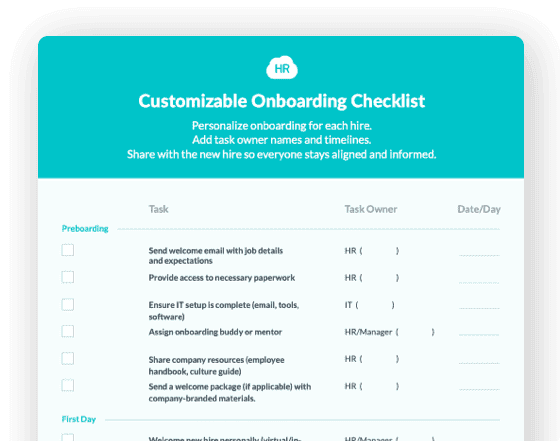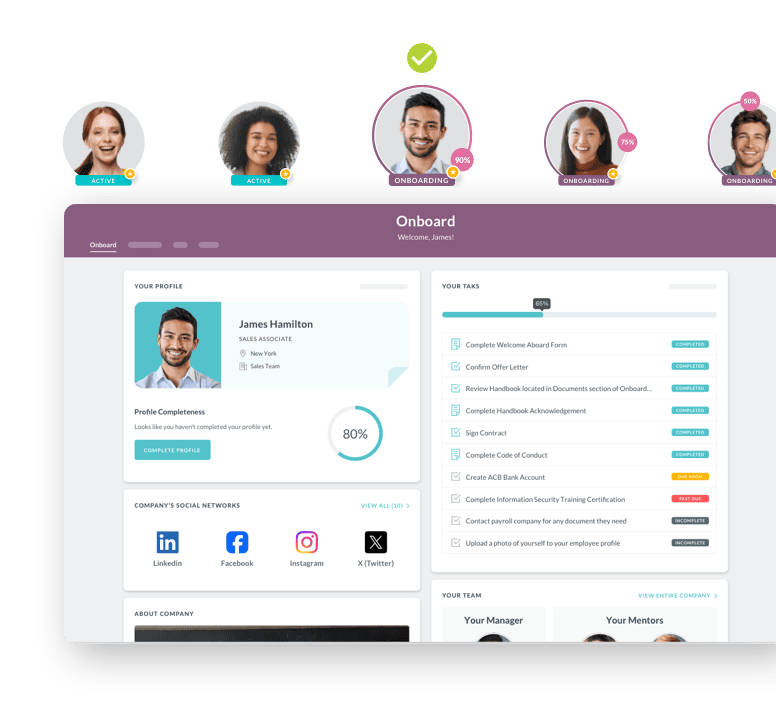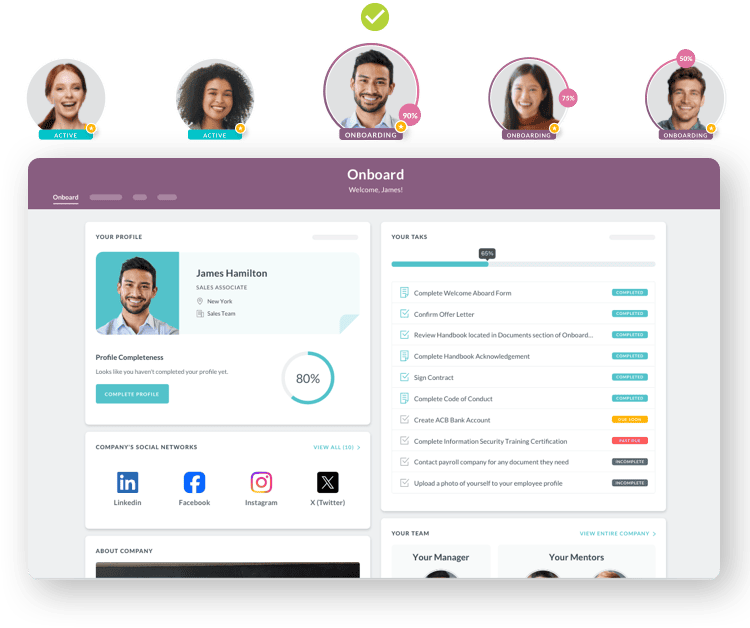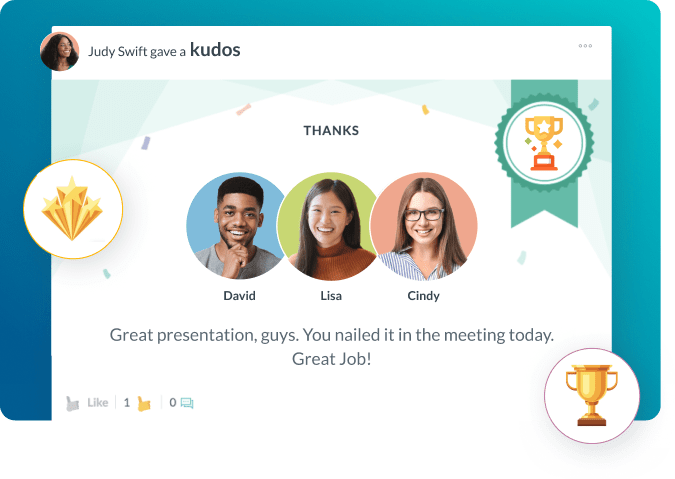Job Onboarding
- Essential Elements of Effective Job Onboarding
- Comparing Traditional vs. Modern Job Onboarding Approaches
- Best Practices for Building Strong Job Onboarding Programs
- Common Pitfalls That Undermine Job Onboarding Success
- How Different Industries Apply Job Onboarding Principles
- Step-by-Step Implementation Plan for Job Onboarding
- Emerging Trends Shaping the Future of Job Onboarding

 Cut onboarding time
by 60%—here's the
Ultimate Checklist
that helped do it.
Cut onboarding time
by 60%—here's the
Ultimate Checklist
that helped do it.

Job onboarding is the process of integrating new employees into your organization. It helps them understand their roles, connect with their teams, and become productive contributors. Think of it as building a bridge between signing the offer letter and becoming a fully engaged team member.
Good onboarding goes beyond paperwork and welcome tours. It shapes how new hires feel about your company from day one. Research from SHRM shows that organizations with strong onboarding processes improve new hire retention by 82% and boost productivity by over 70%. When you invest in welcoming people properly, they stay longer and perform better.
This process matters because your new employees are at their most vulnerable during their first few months. They're learning your culture, figuring out workplace norms, and trying to prove themselves. A structured approach helps them navigate this transition with confidence. Harvard Business Review research confirms that up to 20% of staff turnover happens within the first 45 days of employment. That means poor onboarding costs you talent and money.
The best job onboarding programs create lasting impressions. They help new hires feel valued, prepared, and excited about their future with you. When done right, onboarding becomes your first opportunity to show employees what your company stands for and why they made the right choice.
Essential Elements of Effective Job Onboarding
Before diving into tactics and tools, you need to understand what makes job onboarding successful. Here are the core elements every program should include:
-
Pre-boarding activities that start before the first day, including welcome messages, paperwork completion, and equipment setup
-
Clear role expectations that outline responsibilities, performance goals, and how success will be measured
-
Cultural integration through team introductions, company value discussions, and social connection opportunities
-
Technical training that covers systems, tools, and processes specific to the role
-
Manager involvement with regular check-ins, feedback sessions, and mentorship throughout the first 90 days
-
Milestone tracking to monitor progress and address challenges before they become problems
Comparing Traditional vs. Modern Job Onboarding Approaches
|
Aspect |
Traditional Onboarding |
Modern Onboarding |
|
Duration |
1-3 days focused on orientation |
30-90 days or longer with structured milestones |
|
Focus |
Paperwork and compliance |
Experience, engagement, and culture fit |
|
Technology |
Paper forms and in-person meetings |
Digital platforms with automation and self-service portals |
|
Measurement |
Basic completion tracking |
Performance metrics, engagement scores, and retention data |
|
Team Involvement |
HR-driven process |
Collaborative effort across HR, managers, and peers |
|
Customization |
One-size-fits-all approach |
Role-based and personalized experiences |
Best Practices for Building Strong Job Onboarding Programs
Creating an exceptional onboarding experience requires strategic planning and consistent execution. The goal is to make every new hire feel prepared, supported, and connected from the moment they accept your offer.
Start by mapping the entire employee journey. Look at touchpoints from offer acceptance through the first year. Identify where you can add value and remove friction. Consider what information people need at each stage and who should deliver it.
Here are proven practices that drive results:
-
Launch pre-boarding immediately after offer acceptance to maintain momentum and build excitement. Send welcome packages, complete paperwork digitally, and share resources about your company culture. This keeps new hires engaged during their notice period.
-
Assign onboarding buddies or mentors who can answer questions, provide guidance, and help newcomers navigate informal workplace dynamics. According to research, employees with mentors during onboarding are significantly more likely to stay long-term.
-
Create role-specific training paths that address the unique needs of different positions. Your sales team needs different resources than your engineering team. Tailored content shows you understand what each person needs to succeed.
-
Schedule regular check-ins at 30, 60, and 90 days to gather feedback, address concerns, and adjust your approach. These conversations help you catch problems early and show new hires you care about their experience.
-
Use technology to automate repetitive tasks while preserving human connection for meaningful interactions. Modern employee onboarding software handles paperwork, tracks progress, and sends reminders so your team can focus on relationship building.
-
Celebrate milestones and early wins to build confidence and reinforce positive feelings about the role. Recognition matters from the very beginning, not just after someone has been with you for years.


Common Pitfalls That Undermine Job Onboarding Success
Even well-intentioned companies make mistakes that sabotage their onboarding efforts. Understanding these pitfalls helps you avoid them in your own program.
Many organizations treat onboarding as a checklist rather than an experience. They focus on getting paperwork signed and compliance boxes checked without considering how the process feels to new employees. This transactional approach misses the opportunity to build engagement and connection.
Watch out for these common mistakes:
-
Overwhelming new hires with too much information at once. Spreading learning over time improves retention and reduces stress. Break complex topics into digestible pieces.
-
Neglecting the social aspects of integration. People need to feel like they belong. If you only focus on tasks and tools, new employees may feel isolated even if they understand their jobs.
-
Failing to involve managers adequately. When HR runs the entire show and managers stay disconnected, new hires miss crucial context about expectations and team dynamics.
-
Using outdated or inconsistent processes. If your onboarding experience varies wildly between departments or feels stuck in the past, you signal that your organization isn't organized or forward-thinking.
-
Ending onboarding too soon. Most companies stop after the first week or two. But employee engagement research shows that meaningful onboarding should extend through the first 90 days or longer to truly impact retention and performance.
How Different Industries Apply Job Onboarding Principles
Job onboarding looks different across industries, but the core principles remain the same. Let's explore how various sectors adapt these concepts to their unique needs.
Healthcare organizations face complex compliance requirements and patient safety concerns. Their onboarding programs emphasize credential verification, safety protocols, and hands-on clinical training. New nurses might spend weeks shadowing experienced staff before taking full patient loads. The stakes are high, so thoroughness matters more than speed.
Technology companies often prioritize cultural fit and rapid skill development. They use remote onboarding platforms to integrate distributed teams and leverage digital tools for technical training. Many tech firms extend onboarding through the first six months, with structured learning paths that help developers, designers, and product managers ramp up on complex systems.
Retail and hospitality businesses must onboard high volumes of frontline workers quickly and efficiently. They rely on standardized training modules, clear visual guides, and peer mentoring programs. Employee self-service onboarding allows new hires to complete paperwork and training on their own schedules, which works well for shift workers with varied availability.
Step-by-Step Implementation Plan for Job Onboarding
Ready to build or improve your job onboarding program? Follow this structured approach to create an experience that drives engagement and retention.
Step 1: Assess your current state.
Gather feedback from recent hires about their onboarding experience. Identify gaps, pain points, and areas where people felt unprepared or confused.
Step 2: Define clear objectives.
Determine what you want new employees to know, feel, and do by specific milestones. Set measurable goals for retention, time-to-productivity, and engagement.
Step 3: Map the onboarding journey.
Create a timeline that spans from offer acceptance through the first 90 days or beyond. Identify key activities, stakeholders, and resources for each phase.
Step 4: Build or select your technology platform.
Choose tools that automate administrative tasks while supporting personalized experiences. Look for features like workflow automation, digital forms, progress tracking, and integration with your existing HRIS systems.
Step 5: Create role-specific content.
Develop training materials, resources, and documentation tailored to different positions. Include videos, guides, and interactive elements that make learning engaging.
Step 6: Train managers and buddies.
Equip the people who will deliver onboarding with the skills and resources they need. Make sure they understand their responsibilities and feel confident in their roles.
Step 7: Launch with a pilot group.
Test your program with a small cohort of new hires before rolling it out company-wide. Gather feedback and refine your approach based on real experiences.
Step 8: Measure and iterate.
Track key metrics like retention rates, time-to-productivity, and employee satisfaction scores. Use data to continuously improve your program over time.
Emerging Trends Shaping the Future of Job Onboarding
The landscape of job onboarding continues to evolve as technology advances and employee expectations shift. Staying ahead of these trends helps you remain competitive in attracting and retaining talent.
Artificial intelligence and automation are transforming how companies deliver onboarding experiences. Smart systems can personalize learning paths, answer common questions instantly, and identify new hires who might be struggling. This technology frees up your team to focus on high-value human interactions while ensuring nothing falls through the cracks.
Hybrid and remote work models require new approaches to integration. Companies must create compelling virtual experiences that build connection despite physical distance. This includes virtual office tours, digital culture-building activities, and tools that help remote workers feel part of the team from anywhere.
Continuous onboarding is replacing the traditional start-and-stop approach. Forward-thinking organizations recognize that onboarding isn't just about the first few weeks. They're building programs that support employees throughout major transitions like role changes, promotions, and team transfers.
Data-driven decision making allows you to optimize your program based on actual outcomes rather than assumptions. By tracking metrics and analyzing patterns, you can identify what works and what doesn't, then allocate resources accordingly.
Employee engagement platforms now integrate recognition, communication, and onboarding into unified experiences. This holistic approach helps new hires feel welcomed while giving them tools to stay connected and appreciated throughout their tenure.
The organizations that win in the future will be those that view onboarding as a strategic advantage rather than an administrative burden. When you help people thrive from day one, you create a foundation for long-term success that benefits everyone.
Keep Reading
Credential Tracking in Healthcare: How to Automate License Renewals and Stay Audit-Ready
A nurse shows up ready for her shift but her license expired yesterday. You scramble for
Onboarding 500 Nurses a Year: Lessons from High-Volume Hospital HR Teams
Hiring 5 nurses can be done off-the-cuff. But hiring 500 is a logistics operation by
AI for Frontline HR: Moving Beyond Sentiment Analysis to Build Tomorrow's Workforce Management Engine
TL;DR: While most organizations limit artificial intelligence in human resources to basic
Ready to streamline your onboarding process?
Book a demo today and see how HR Cloud can help you create an exceptional experience for your new employees.







